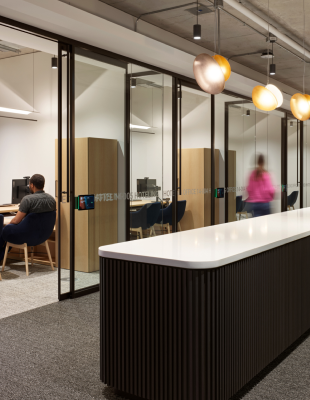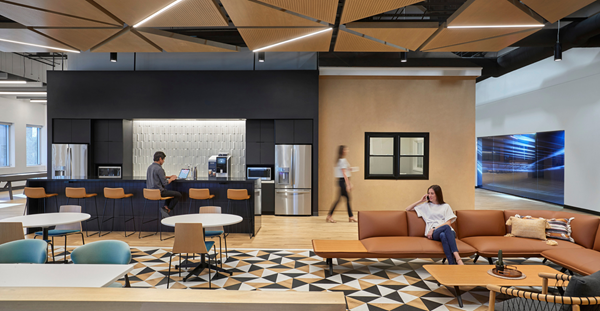Post-occupancy evaluation (POE) is a standardized and customizable data-driven process to enhance design quality by evaluating the alignment between the design intent and outcomes from occupant experience and building performance perspectives. Implementing POE in projects provides a holistic perspective of project success that benefits designers, clients, and occupants.
Despite a lack of industry investment in this field, looking at POE from a holistic perspective is a must as there are several stakeholders involved in the design and occupation process. For architects, POE provides important insights they can utilize to improve future design outcomes. For clients, POE measures the impacts of the design decisions on the occupant’s experience, wellbeing and satisfaction, and building performance. Additionally, POE shows the return on investment (ROI) by demonstrating how a design contributes to the project's environmental, social, and economic benefits.
Due to the noticeable value in cross-market and cross-region conversations about POE, and to build a holistic POE framework, Arcadis invested in a firmwide exploratory research. Our research study enabled us to understand the benefits and obstacles for POE implementation, and strategies to overcome the obstacles across markets and regions. This study also helped Arcadis to identify the markets in which to design and implement the POE framework. As a result, Arcadis has built momentum around POE and developed a framework and modular template that will change the way architects and clients perceive POE.
We have tailored and tested this framework for our workplace practice before we expand it to other markets. Our customizable and standardized framework evaluates employee experience and building performance and helps clients and designers select metrics and data based on their design goals.
Evaluating POE perception inside a large architecture practice
From 2022-2023, a team of three Global Research Fellows, John Naranjo, Rachel Bruce, and Wei Xia, led by Dr. Helia Taheri, Arcadis’s Global Human Centric Research Manager, strategized an award-winning research for a firmwide mixed methods study to gain wide-ranging perspectives on POE by engaging architecture professionals from various regions and markets. We involved over 160 people in this process through a firmwide survey, eight focus groups, and two interviews. We presented the findings in conferences such as EDRA55 and IAPS2024.
The data collected shows many benefits for introducing POE during the project lifecycle. The POE process helps architects learn from their previous designs, maintain client relationships, and inform future project choices. It benefits our clients by ensuring the intended design is aligned with design outcomes. Additionally, POE benefits the occupants and visitors by giving them an opportunity to share feedback and contribute to design decisions.

Insights and suggestions for optimization
Despite the benefits of POE, we uncovered numerous roadblocks. Study participants cited concerns around budget and who will pay for the implementation and analysis; the lack of a standardized and customized process; insufficient knowledge within an organization about the value and process; lack of access to clients’ buildings and their users, and more.
The study also produced practical recommendations that architecture practices can implement when faced with these challenges. Suggested tools and deliverables include developing a user-friendly database and a standardized and customizable toolkit to facilitate the POE process. Speaking with clients as early as possible about POE, in addition to referencing the approach in proposals and contracts and implementing a change management program that prioritizes the education of design teams about the process and its value are some of the recommended strategies.
This study also indicated that the practice areas with the greatest opportunity, and the least amount of difficulty, are the workplace, higher education, schools, and healthcare. Each practice area has its own advantages – from a client’s familiarity with POE and their long-term vision of the project to gaining building access – making application easier to achieve in these settings.
Our findings confirmed what we already knew about POE, and they support its use as an integral part of the design process, from before the contract is signed to after the project has been completed. The study also raised concerns about the language we use when talking about post-occupancy evaluation and whether we should consider an all-encompassing designation that more accurately reflects the purpose of these evaluations: measuring a project’s success.

Measuring project success in the workplace
Today’s hybrid workplace requires a more data-driven design. The goal of measuring project success in a workplace context from beginning to end is to understand how well the designed space meets the needs of the client, its employees, and their visitors; how we can improve on our future projects; and how we can identify emerging patterns in different regions and office types, among other objectives.
Arcadis’s workplace framework provides a holistic perspective of a hybrid office environment with multiple key performance indicators (KPIs) to measure office utilization, employees’ satisfaction, productivity, health and well-being, indoor environmental quality, and more. Additionally, this framework includes different data points such as employee survey, badge data, and design features to name a few. We believe future application of a standardized approach pre- and post-occupancy is feasible across many practice areas and an important step to achieving design success.
In our next blog posts, we will share more about our framework to measure success in the workplace. We will also share how we have implemented it to Arcadis’s redesigned offices and clients’ projects and demonstrate how we contribute to a workplace that helps people thrive by designing healthier, more productive – and better – spaces for our employees and our clients.
Photos by Garrett Rowland Photography.






